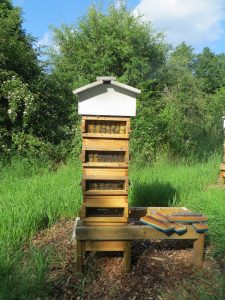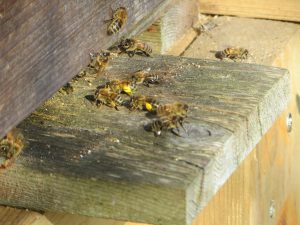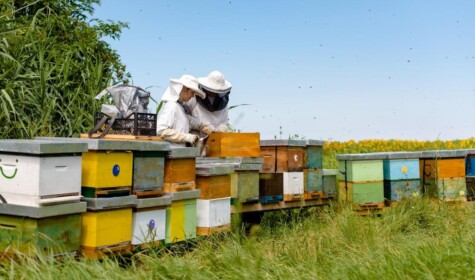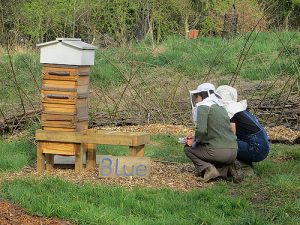It is a great privilege to call myself a beekeeper. Having bees in my life, constantly reminds me to notice the sheer wonder of the world around me and often leaves me with a visceral sense of my place within this world. Honeybees have seen a dramatic rise in public awareness and beekeeping has exponentially increased in popularity, however the mindset of industrial farming is still alarmingly prevalent in beekeeping practice, and how it is discussed and taught to the next generation of beekeepers.


The framed hive, a fundamental component of much contemporary beekeeping, is itself an expression of this ‘part’ focused mindset. Frames are wooden components of vertical hives that contain comb and are removable. The invention of frames meant that, for the first time, beekeepers could enter into the heart of the hive, which previously had been difficult to access without causing serious damage. Over time this accessibility has led to an assumption that beekeeping involves entering the hive to manipulate individual components of the superorganism. However, this assumption has several problematic implications for the health of honeybees.
Honeybees, if left alone, maintain the internal environment of their nest with extraordinary precision. The area within the nest where the young bees are raised is maintained at 35⁰ C constantly. The bees use the muscles that power flight to generate this heat. This process produces a womb-like environment that is ideally suited for the optimal development of the young bees. The routine opening of the honeybees’ nest inevitably involves releasing this heat. It has become my working assumption that the changes in the hive’s atmosphere have negative health implications for the young bees which consequently affect the health of the whole family.
The space in which honeybees evolved is the hollow tree, generally high up in the canopy of the forest. The hollows are created by various fungi rotting out the heartwood of the tree and honeybee families carefully select hollows that are ideally suited to their needs. A family would move into this cavity, lining the inside with propolis to sterilise the space and then fill it with wax honeycombs. Bees survived in these spaces for millions of years. If we imagine for a moment the thermodynamics of this internal space we will see that the thick wood surrounding the nest provides a stable insulated environment where it is easy for the bees to control the temperature. It is also interesting to consider that the process of making honey involves evaporating water in the nest. Nectar, when it arrives in the hive, is typically about 80% water and 20% sugar; if left untouched this solution would ferment. The bees evaporate water from the nectar until the sugar content reaches 80% – only then are the bees satisfied that this is honey and won’t ferment. It is then capped with wax and stored to support the bees’ survival through the winter. Bees have evolved to live in a warm and humid nest in an undisturbed cavity.
Compare this internal nest space with that of the contemporary hive: much thinner walls, much larger entrance space, open mesh floor, no insulating material above, routine opening of the roof. We can quickly see that these hives function somewhat like a chimney, drawing heat, moisture and chemicals released by the bees, up through the nest space. As I began to understand this, I started to search for hive designs that mimicked the way hollow trees work and fortuitously came across alternative designs.The hive that I predominantly use to this day is narrower than most hives, contains a layer of insulation at the top of the nest and has no frames so the bees build natural comb. The design dramatically reduces the need to open the hive from the top. The internal space functions remarkably like a hollow tree, yet it is possible to make interventions within the nest space while causing minimal disturbance.
The beekeeping environment has changed dramatically over the last 10 years. The mindset at the very heart of industrial farming – which focuses on the increase of yield above the value of overall health – that once dominated perspectives on working with bees, is shifting. There is now a growing plurality in how beekeepers work with bees, and beekeepers across the spectrum are increasingly open to new perspectives. However, this change in beekeeping practice is still marginal and in itself does not negate the wider environmental issues of habitat loss and fragmentation, widespread pesticide, herbicide and fungicide use, soil erosion, water contamination and dwindling sources of nectar and pollen.
In my experience, working with honeybees opens us to a wider sense of connection and participation within the biosphere. A honeybee family is an integral part of the life-cycle of plants and trees for 3 kilometres in every direction. As a beekeeper, being part of this process has left a visceral imprint on my experience and practice. It is only with a wider perspective of the wholeness of the biosphere and our place within it, that we will be able to overcome to the environmental challenges we face today.
This article was originally published December 2017.




